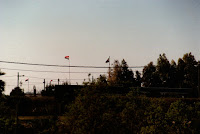Two weeks ago I spent several hours assisting a "friend" shopping for a replacement bicycle. I am doing my utmost to help her find a bike that suits her riding style and preferences without coercing her to adhere to my opinions on what would be the best bicycle for her. She is looking for a new bike because both of her bikes were lost in a house fire. The fire has left her without a ride and thus at seventy three she is looking for a new bicycle. Fortunately, for her, it was not her house and she only lost the bikes, two westen saddles, and other horse tack. The house that was lost was her younger sister's, she had been keeping her bikes there so they could ride together for fitness. Unfortunately her sister lost the entire house and everything she owned except for her vehicles. The good news is that the sister was able to drag her adult, quadraplegic son from the house with no injuries.
One of the bikes lost was an unsuspended Specialized Hardrock and the other was a full suspension, Fuji Diamond Comp. The Specialized was the first bicycle she owned since sharing one with siblings. A bicycle without a chain had been given to her family to be shared amongst the twelve children. The children rode it by pushing it to the top of a hill and coasting to the bottom. Sometimes the hill was a slope in the yard, at other times they were on the gravel road before the house. Her husband and I purchased the Specialized for her on their anniversary in late 1997, teaching her to ride at the age of 57. This late interest in cycling developed when her husband, also not having owned a bike as an adult, borrowed one of mine to try to get back in shape the year prior. The bicycle buying spree began when she and I bought him a Specialized coaster bike early in '97, a bicycle which fit him better than my bike did. The bike purchase for her was so they could spend their exercise time together instead of separately.
She continued to ride after being widowed in 2000, the thought of riding alone did not deter her. As she gained experience and confidence she increased the difficulty of the terrain onto which she ventured, to include rails to trails routes and fire roads. In 2004 I rode with her on the lower portion of the Virginia Creeper Trail, we set out from Abingdon, Virginia and rode a few miles. She took it upon herself to shop for and purchase the Fuji late in 2005 while working in Charlottesville, Va. She rode that bicycle on rural roads and trails in Virginia, North Carolina, and Tennessee.
 |
| At the head of the Virginia Creeper Rail to Trails |
My "friend" is looking for a bike which she can use on rural roads, gravel roads, fire trails, and levee embankments around wildlife preserves. She has established her price range and defined the terrain she will be riding. Knowing this leads me to recommend either a hardtail mountain bike or a suspended hybrid bicycle. If we find a bicycle with a suspension seatpost that would be considered a bonus. If the bicyle she chooses does not have a suspension seat post I have two in a bin and hopefully one would fit. Another option would be to purchase a shock post separate from the bicycle.
Purchasing from a shop, as opposed to an online retailer, is our best choice since she is not familiar with the options available and how she would like a particular choice. In our search we must travel at least 60 miles to find a bicycle shop, two are to the south and more to the north at a greater distance. The only thing closer are the bicycle sections at various small town Wal-Marts. Neither she nor I are brand purists, leaving us more options from which to choose. I guess that could be considered a blessing or a curse. The choices are narrowed because she prefers not to have a bike with twist/grip shifting. So far the top contenders are a hybrid by Giant and a mountain bike by Fuji. In the past she had been strongly against "girl's" bikes but surprised me while we were shopping and expressed a stronger interest in step through frames. I'll let you know how things turn out.
I'm glad I am able to assist my



















